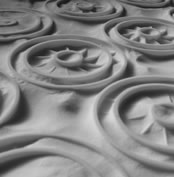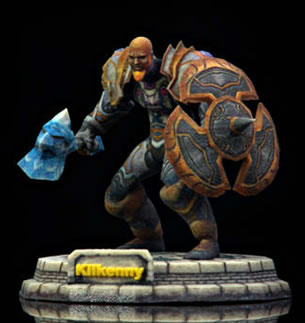Rapid Prototyping Down the Road
More efficient, cleaner, cost cutting technologies that present new ways to prototype and manufacture products.
Latest News
February 14, 2008
By Susan Smith
From the time I first became aware of rapid prototyping in the early 1990s, the technology has become increasingly persistent in the 3D solid modeling design process. Although its predecessor and counterpart, digital prototyping, still has an important place in 3D modeling today, the need to create a physical 3D model still exists. For new designs, a physical prototype is preferable to ensure that the product is built the way you imagined it, with the right look and feel that you or your client envisioned.
As with everything, the only constant is change. As newer, more efficient technologies come on the scene, sales of some of the older, mature technologies such as stereolithography, are not growing at the same rate as newer generation technologies, according to Terry Wohlers, principal consultant and president of Wohlers Associates, Inc. Stereolithography is still being used by some large organizations and service providers, but many companies have adopted newer technologies. “There are inkjet systems that can deposit photopolymer and harden it layer by layer,” said Wohlers, “It’s less expensive, faster and safer than doing it the old way. Even so, stereolithography still has the edge when it comes to the number of material options available for it.”
Clearly, while some mature systems are on a decline, the new generation systems have enjoyed healthy growth over the past few years and continue to do so, more than making up for the loss of revenue from the older systems.
Laser sintering is an example of a mature technology that is being challenged by new alternatives. “Today there are systems that can sinter layer by layer but do not require a laser,” said Wohlers. “Lasers are expensive and not particularly fast. In comparison, the new alternatives can sinter an entire layer at once. When you consider that a laser must draw across the entire surface, it is relatively slow compared to doing an entire layer at once.”
 Wohlers points to approaches that are already commercially available, one from Sintermask (Molndal,Sweden) that can produce impressive parts in a glass-filled nylon material. The process uses a photocopying process to generate individual masks and infrared radiation to solidify each layer. German-based Voxeljet (Augsburg, Germany), a sub licensee of Z Corp (Burlington,MA), offers a process that is similar to that of Z Corp, except for two differences: material type and difference in size. Voxeljet uses a PMMA, an industrial grade plastic powder with a binder jetted onto it. The machines are big and they can build large parts. “That’s a new spin on an existing technology that I believe will develop over time,” said Wohlers.
Wohlers points to approaches that are already commercially available, one from Sintermask (Molndal,Sweden) that can produce impressive parts in a glass-filled nylon material. The process uses a photocopying process to generate individual masks and infrared radiation to solidify each layer. German-based Voxeljet (Augsburg, Germany), a sub licensee of Z Corp (Burlington,MA), offers a process that is similar to that of Z Corp, except for two differences: material type and difference in size. Voxeljet uses a PMMA, an industrial grade plastic powder with a binder jetted onto it. The machines are big and they can build large parts. “That’s a new spin on an existing technology that I believe will develop over time,” said Wohlers.
3D Printing fits into that category of new technologies where the costs continue to decline. “The cost of producing the physical model will decline to the point where it’s a no brainer, because the benefits of having it in your hand will far outweigh the cost of making the model,” Wohlers said.
The promise of new low end 3D printing systems seems to linger at the tantalizing carrot stage, as the vendors of such products still do not have much to show and no parts to give away as examples. In the case of the Desktop Factory offering, expected to be released for under $5,000, Wohlers said, “That’s impressive but the company must sell thousands eventually to really make money on a system that sells for $5,000.”
Wohlers talked about the challenge of photopolymer technology, which is what 3D Systems uses. The system uses the layering process spoken of earlier, “but is imaging an entire layer of photopolymer in a flash of light. Incidentally, it is a process similar to the Perfactory system from EnvisionTec, which uses a Digital Light Processing (DLP) chip from Texas Instruments. DLP technology is also used in data projectors and televisions.”
Medical
Gradual growth in the medical industry has created a wider use of additive fabrication technology for producing models as visual aids for surgeons in preparation for complex surgeries. Most of these involve cranial facial and maxillofacial reconstructive surgeries, and cases of conjoined twins, according to Wohlers. Doctors who embark on these surgeries benefit from being able to see what the body is like before actually doing the surgery. “The advanced planning increases the likelihood of the surgery taking less time, a big benefit for the patient,” Wohlers explained. Unfortunately, many insurance companies aren’t familiar with these new methods of medical modeling, even though the costs savings can be as much as $10,000 or more on one surgical procedure, by using a single $2,000 model, Wohlers explained.
Another area where the medical industry is beginning to take advantage of additive processes include orthopedics, in such applications as metal implants for joints such as knees and hips. Arcam AB (Molndal,Sweden) uses the electron beam melting approach to manufacture implants.
Medical applications are advancing well beyond metal joint implants, however. “The ‘Holy Grail’ is the 3D printing of live tissue, whether it’s bone, or even soft tissue, and eventually organs. Scientists have done bone implants on many dogs, cats and rabbits and demonstrated it is possible,” said Wohlers. “The manufacture of organs will be more difficult, but I’m convinced it’s just a matter of time. In the future, we will be printing kidneys, livers, hearts and other organs on demand. In some cases, we’ll print partial kidneys, livers, etc. to replace what’s missing or damaged.”
The Entertainment Industry
 Wohlers refers to the entertainment industry as a “sleeping giant,” specifically the video game industry where companies such as Electronic Arts and Blizzard Entertainment are producing 3D models. The entertainment industry has been creating 3D virtual models for some time, but now there is a demand from people who want to build custom characters from their new generation video games. Many of the models are not of high resolution or fully closed volumes as required by additive fabrication.
Wohlers refers to the entertainment industry as a “sleeping giant,” specifically the video game industry where companies such as Electronic Arts and Blizzard Entertainment are producing 3D models. The entertainment industry has been creating 3D virtual models for some time, but now there is a demand from people who want to build custom characters from their new generation video games. Many of the models are not of high resolution or fully closed volumes as required by additive fabrication.
FigurePrints, the brainchild of a former Microsoft vice president who ran its video game business, is about taking a character from World of Warcraft (one of the most popular video games in the world) and building a personalized character, explained Wohlers. FigurePrints uses the color machines from Z Corp to “pull your character from the virtual world and bring it to life.” As people play with their characters, these characters become personalized and grow much richer than they were when they started, as characters in series or novels grow. Each figure is unique.
“There are millions of these personalized characters that many people may want to have built,” said Wohlers. “You can submit your Warcraft characters to FigurePrints.com and they’ll build it for you.”
Wohlers said that this will help grow the industry of additive systems and that we’ll see a growing amount of non-technical data that may eventually exceed the number of CAD models being produced.
“Today, 99% of the physical models being built from 3D printers and other additive systems are from CAD systems. In the fields of medicine, aerospace and motor sports, we are seeing parts being produced in cobalt-chrome and titanium.” Wohlers predicts great growth in direct digital manufacturing (DDM), also referred to as rapid manufacturing, in the next few years. Materials will be a big area of development, just as it has been with traditional manufacturing.
Green Rapid Prototyping
To date, the importance of being green has not yet become a topic of importance among those close to additive fabrication, but it’s only a matter of time, according to Wohlers. He explained that by its very nature, additive processes are a lean method of producing parts. In the future, it could play an interesting role in reducing greenhouse emissions, especially in the context of rapid manufacturing.
Summary
In summation, what do we have? New, more efficient, cleaner, cost cutting technologies that present new ways to prototype and manufacture products. Markets such as automotive and medical are spurring development of new materials in their quest to solve difficult challenges with additive fabrication technology. New kids on the block, such as the entertainment industry, offer breakthrough “non-technical” data that hint at launching new and profitable markets for additive system and material developers.
Subscribe to our FREE magazine, FREE email newsletters or both!
Latest News
About the Author
DE’s editors contribute news and new product announcements to Digital Engineering.
Press releases may be sent to them via [email protected].






